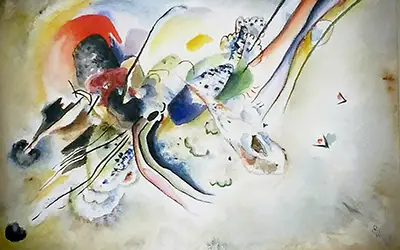 Buy Art Prints Now
Buy Art Prints Nowfrom Amazon
* As an Amazon Associate, and partner with Google Adsense and Ezoic, I earn from qualifying purchases.
This is a lesser known painting from abstract painter Wassily Kandinsky but is highly attuned with the style for which he was most famous. With little information available on it, we will concentrate on his Composition series which dominates his career oeuvre.
Kandinsky left behind at least ten different paintings that were left titled simply as "Composition". In modern times, most would use the term untitled instead, but essentially it is the same process of leaving an artwork without a specific name. It is a frequent occurrence within modern art, where artworks end up being identified purely by the year of their creation or in some cases a specific number of iteration. In contrast to this have been the likes of Dali who provide extraordinarily long names to their paintings which are hard for publishers to provide in full, such as Dream Caused by the Flight of a Bee Around a Pomegranate a Second Before Awakening and The Disintegration of the Persistence of Memory. Kandinsky may not have wanted to distract viewers with a title that may have made them search for elements in the scene, which may not even have been there.
To look at this scene, what do we see? It could be a landscape scene, delivered on a slant. If we rotate the painting to the right, we can view rolling hills plus all manner of additional elements which could be trees plus other natural features. But we still can’t be sure and the artist does little to help us. He liked to leave a certain amount of mystery to his work during this period as he consciously moved away from traditional art - Kandinsky was a passionate advocate of modern art and famously “declared war” on what we saw during the Renaissance and Baroque periods.
Kandinsky was a crucial part of the abstract movement which took over the 20th century. He took on critics and forged a path for future artists to follow. These others would appear from across Europe as well as in the US too, as this movement towards abstraction continued to build a formidable momentum that intended to leave traditional art behind once and for all. Within Germany there were several significant art movements which did much of the hard work and make progress by slowly convincing the public of the merits of their work. Kandinsky famously explained how he limited his development to small incremental changes in order to avoid alienating the public and critics alike, conscious that he needed them to follow him on this journey.




